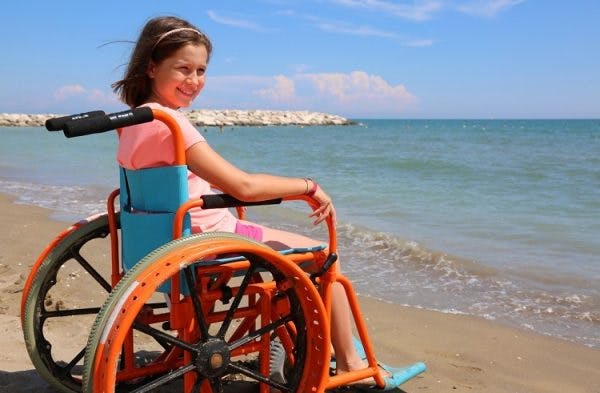The most effective sensory activities for cerebral palsy encourages children to become more accepting of their surroundings through repetitive exposure.
Although sensory problems are not directly related to cerebral palsy, they can co-occur.
Cerebral palsy is a motor disability caused by damage to the developing brain. Depending on the size of the brain damage, areas of the brain that process sensory signals from the body may also be affected.
This article will share 7 effective sensory activities that help children with cerebral palsy feel more comfortable with the world around them. But first, let’s go over why sensory problems occur and their symptoms.
Sensory Problems in Children with Cerebral Palsy
Sensory problems are the result of the brain being unable to process sensory information correctly.
This determines how your child reacts to certain touches, sights, sounds, tastes, and smells.
It also involves your child’s sense of body awareness (proprioception), balance, and movement.
Children can be either over or under sensitive to sensory stimuli.
Common signs of sensory problems in children with cerebral palsy include:
- Hesitant or avoidant behavior
- Difficulties latching during breastfeeding
- Irrational tantrums
- Sensitivity to bright lights, strong smells, loud noises
- Tensing their body
- Overactive behavior (running around, spinning in circles, jumping)
Children who have difficulty recognizing sensory stimuli often are hyperactive and crave lots of stimulation.
In contrast, children who are overly sensitive to sensory stimuli generally demonstrate avoidant behaviors because they feel overwhelmed.
Sensory Activities for Cerebral Palsy
Sensory activities for children with cerebral palsy are designed to be repetitive.
The more your child exposes themselves to unfamiliar stimuli, the more comfortable he or she will be around them.
Every child’s sensory problems are unique, so it’s essential to take a personalized approach. Watch your child’s reactions and adjust their activities as needed.
Below are suggestions for sensory activities.
1. Painting

Painting is an effective way to introduce your child to a variety of different sensory stimuli.
For tactile (touch) development, children can use their fingers, brushes, or sponges. This will help develop their sense of pressure.
Additionally, try experimenting on different types of surfaces (on paper, on styrofoam, on a wall, etc.). This will expose your child to various textures.
For safety (or more fun) you can use colored whip cream in case they put their fingers in their mouth.
2. Bath Time
Make bath time an interactive experience for your child by including toys and bubbles.
Play is one of the most effective ways for children to learn.
Include a variety of different toys: ones that sink or float, that are soft or hard. This provides your child a variety of sensory stimuli during play.
3. Pacifier Training
If your infant has cerebral palsy and demonstrates difficulties latching during breastfeeding, they may have difficulties controlling the muscles around their mouth. This could also be a sign of tactile sensitivity.
To help your child become more familiar with having something in their mouth, use a pacifier throughout the day.
4. Sand Box Play
Playing in a sandbox is a fun way for children to develop their sensory skills.
Let your child play in dry sand for a while and then apply water to some of the sand. Let them feel how the texture and pliability changes.
Creating sandcastles, using shovels and buckets, and drawing on the sand are all great activities to practice tactile development.
5. Rocking Chair
Rocking in a rocking chair or rocking horse is an effective way for children to develop their vestibular system.
The vestibular system is responsible for understanding balance during movement.
Gentle rocking can help your child become accustomed to shifting their weight, adjusting their posture, and feeling more at ease in motion.
6. DIY Drum Set

Create a do-it-yourself drum set for your child by collecting a variety of different objects to tap on.
Everyday objects that you can find around the house like metal pots, plastic buckets, and cardboard boxes make great drums.
Have your child practice tapping their hands or “drumsticks” (markers, chopsticks, etc.) on these surfaces to provide a variety of different sounds.
Adjusting the amount of pressure may also help your child understand how to make the sounds softer and louder.
7. Sorting Candy
Sorting candy is a fun way to train your child’s visual processing skills and hand-eye coordination.
Spread out a bag of your child’s favorite colorful candy on the table.
Then, have your child sort through them and separate them by color.
To make this activity more challenging, consider:
- using smaller pieces of candy
- spreading the candies further apart
- increasing the amount of candy to sort through
Understanding Sensory Activities for Cerebral Palsy
Children with sensory processing difficulties may become overwhelmed at any point during play activity, so always start simple.
If your child is sensitive to sounds, items like vacuums, blenders, and ice machines may easily startle them.
One of the most effective ways to manage sensitivity to sound is to give your child control.
“Let’s make a smoothie! Can you press this button in 10, 9, 8, 7, 6, 5, 4, 3, 2, 1?”
Giving your child the control to press the button will help mentally prepare them for the sound so that it is less frightening.
The more your child experiences new textures, temperatures, sounds, colors, smells, and movements, the better their brains will get at processing sensory information.
Consistent exposure helps the brain become more familiar with stimuli, which will ultimately help children feel less overwhelmed.











